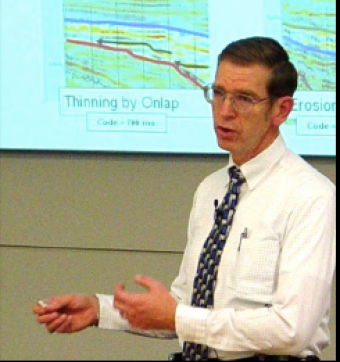1h 10min Advanced
The class time should be divided into three (3) segments: 1) a review of the previous exercise (Exercise 18), 2) present the lecture material provided here, and 3) introduce the exercise. The review of the previous exercise contains five (5) slides, and will take ~8 minutes to explain. The lecture material contains 45 slides, and will take ~50 minutes to discuss. Lastly, the introduction to the exercise contains seven (7) slides and takes ~12 minutes to cover. Thus, this lesson will take ~70 minutes of classroom time.
Besides the lecture material, in the exercise presented here, students will use inlines, crosslines and time slices to map two (2) faults: the Green fault and the Blue fault. Two (2) lines have a fault interpretation to get them started. Crossline 2800 has the Green fault marked. Time slice 1300 has the Blue fault marked.
The introduction tries to illustrate how the classic “fold & transfer” method works for transferring an interpreted fault or horizon from an interpreted line to an uninterpreted line at their intersection point. With the fault marked at the intersection point, we can then interpret the fault on the uninterpreted line. If at an intersection we have two (2) different TWT values for the fault, it is a correlation “bust” (error). If there is a bust, the interpreter has to figure out a way to eliminate the inconsistency. One line might have to be re-interpreted to be consistent with the other – often the structural dip line is more reliable and the structural strike line is “fixed.” It can be that both lines have to be adjusted a little (a compromise) so as to get the fault at a single TWT at the intersection point. Hopefully, the students will appreciate that tying a fault at several line intersections results in an internal consistent fault interpretation.
The students should work the Green fault first on about two or three (2-3) inlines, two or three (2-3) crosslines and about four (4) time slices. Deeper time slices are lower quality (noisy), and so are not as definitive as the shallower slices. Then, the students can work on the Blue fault – about three (3) inlines, and four (4) time slices. Students should work about 30 minutes on this exercise.
At the end of this lecture, students should be able to:

This course, based on teaching material from Dr. Fred Schroeder (formerly of Exxon/ExxonMobil), reflects on the geology and geophysics basics for the petroleum industry. General geology and basic geophysics are not required, but helpful with the material.
We encourage the reuse and dissemination of the material on this site as long as attribution is retained. To this end the material on this site, unless otherwise noted, is offered under Creative Commons Attribution (CC BY 4.0) license